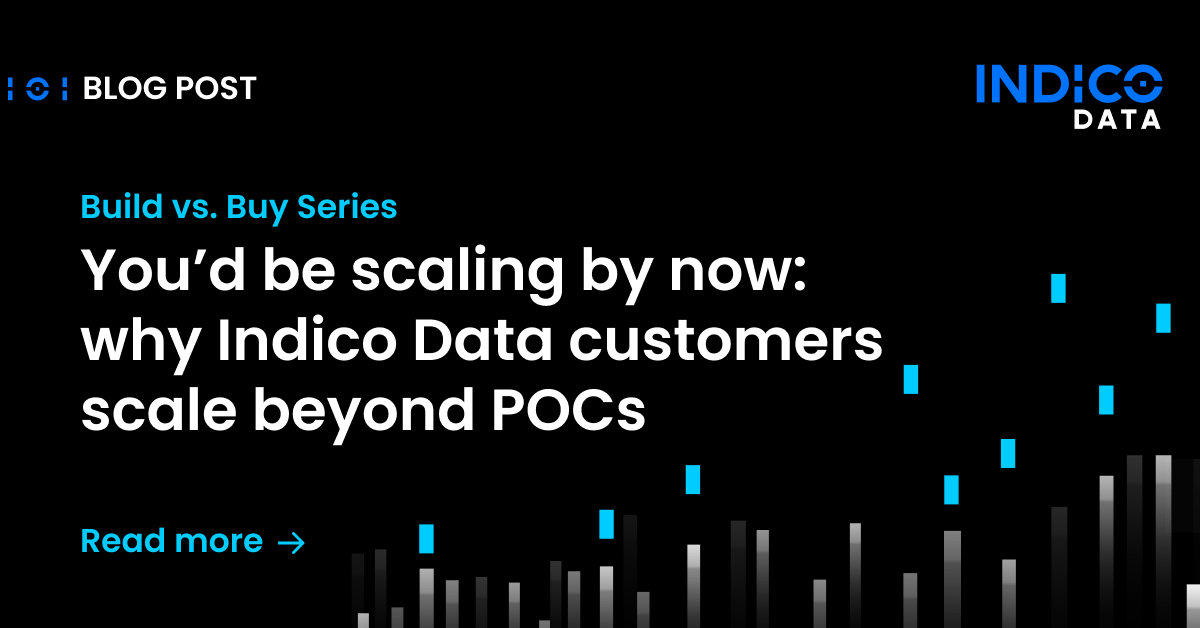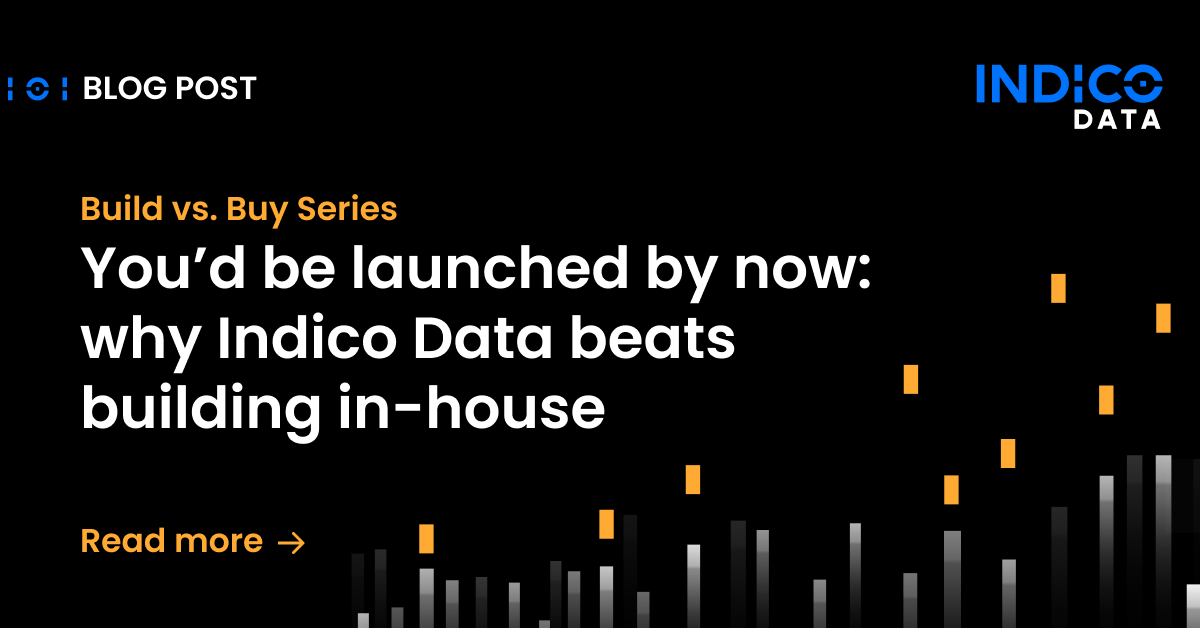In episode 25, Christopher M. Wells, Ph. D., Indico VP of Research and Development, and Michelle Gouveia, VP at Sandbox Insurtech Ventures, speak with Tom Wilde, Indico CEO, about Everest Group declaring Indico a leader in intelligent document processing – and in delivering value.
Listen to the full podcast here: Unstructured Unlocked episode 25 with Tom Wilde
Industry analysts issue no shortage of market reports on various technologies, reports in which customers, vendors and even venture capitalists find value. To learn more about the process through which analysts rank vendors, we talked to none other than Tom Wilde, CEO of Indico Data, which fared quite well in a recent Everest Group report.
Wilde joined my co-host Michelle Gouveia and me for a special 25th episode of our Unstructured Unlocked podcast. I say special because we don’t usually talk much about Indico on the podcast. But Indico being named a “Leader” in the annual Everest Group PEAK Matrix report on Intelligent Document Processing products seemed like a good occasion to break with tradition.
Related content: Everest Group PEAK Matrix report on Intelligent Document Processing
Why analyst reports matter
Analyst reports like Everest’s are important to vendors and customers alike. “From a vendor perspective they’re absolutely critical in helping buyers feel that they have a more impartial source of information about the developments in the market,” Wilde said.
In general, analysts serve two purposes, he noted. One is predicting where a market is going, to help customers understand developments and technology shifts they should pay attention to. “Obviously, we’re in the midst of one of the biggest [shifts] since maybe the smartphone or the browser with GPT,” he said.
The second purpose analysts serve is to give buyers an impartial view into the activity of vendors, which he said, “can be confusing and a bit bewildering for buyers a lot of times.” For that reason, vendors spend lot of time with analysts, educating them on what customers are saying, how their products address customer issues, what’s in the research and development pipeline, and more.
Behind the scenes of analyst reports
As Wilde’s previous post noted, this was Indico’s third time in the Everest IDP PEAK Matrix report, although our first being rated as a “Leader.” So, we asked Wilde, what goes into rising up in the rankings over time?
For starters, it involves the evolution of the Indico intelligent intake solution. “We always felt we had a strong vision as to where this market was going and what capabilities would be required,” he said. “That didn’t mean we had all those capabilities at the time of the particular analyst reports going back, 2, 3, 4 years.”
Not surprisingly, as the product improved, we had more customer success stories we could point to, which is an important component in the analyst report rankings. “We began to be able to demonstrate tangible ROI with customers. That really helped,” Wilde said.
A third component is “our ability to help the analysts understand where the market’s going, how to shape the narrative around market trends and what’s going to be important in the future,” he said. “I think we’ve been leaders in that.”
Those conversations sometimes involved “heated discussions and disagreements about where the market is going,” he noted.
Related content: GPT: Hype, reality, and the Indico generative AI origins story
Semi-structured vs. unstructured data
Those discussions often focused on fundamental disagreements over the nature of data and documents, and what is considered structured vs. semi-structured and unstructured.
“Many analysts we talked to at different firms had really limited their thinking that documents are either structured or semi-structured. And the mistake that we saw in that is that there clearly to us was a third category,” Wilde said.
Here’s the issue. Say a document appears to have some structure to it, maybe a table on one page and a chart on another. A client may look at that document and say it’s semi-structured. But next consider whether all the documents of this type the company has to deal with look the same, with the tables and charts all on the same page, in the same position. Likely the answer is, no, they’re all at least somewhat different. In such a scenario, the documents should be defined as unstructured, Wilde said.
“So that took a lot of convincing and education with the analysts to say, ‘This is what our customers are bringing us, you’re missing a definition for this,’” Wilde said. “Over time, we had a lot of back and forth about that and I think we got to a better place.”
Specifically, Everest this year broke its report into two PEAK Matrix assessments, one for the overall IDP landscape and another for the unstructured document processing landscape.
To Gouveia, who follows the insurance industry technology landscape for the venture capital firm Sandbox Industries, that was a big step forward.
“It’s not like they were missing a small sliver of the overall documents that were being taken in. The majority is unstructured,” she said. “At least from the insurance standpoint, [unstructured] is the major pain point that these solutions should be trying to solve for.”
In the analysts’ defense, “at the time, 99% of the vendors they were evaluating could only handle structured or semi-structured document types, so that was their worldview,” Wilde said. “When we showed up, we were the first to be able to assert that we truly could handle unstructured.”
Indico was also the first to be talking about using artificial intelligence large language models, transfer learning and deep learning techniques. “This was at the dawn of those technologies, at least from a commercial standpoint,” he said. “They didn’t know quite where to put us.”
Related content: Outlining the difference between unstructured, structured and semi-structured data
High marks for full value
Judging by the Everest 2023 PEAK Matrix report, all those analyst conversations have paid off. As Gouveia noted, of all the companies in the “Leader” category, Indico was the only one that received full credit for “value delivered.” She asked Wilde for his take on why that was the case.
“This is sort of hard won on our part in terms of just lessons learned in the field,” he said. “We’ve become really good at helping customers start with outcomes and work backwards towards a solution.”
Often when vendors engage with a customer, especially large companies with lots of resources and smart people, they will come to the table with a solution in mind on how to solve a given problem and ask whether the vendor can deliver on that vision. Indico will sometimes need to challenge that assumption and get the client to look at the problem in a different way.
“Maybe we should start with a better definition of what is the most valuable outcome you’re trying to achieve. And then let’s really talk about possible ways to get there, rather than starting with the answer,” he said.
It’s also helpful to have a discussion around what will be done differently with the new technology solution in place, and whether employees are on board with that.
“More often than not, the people who are actually going to end up using the technology aren’t brought into the loop [early enough] and end up fighting it,” Wilde said. “So, we really draw that to the surface and make sure that’s been considered, before we even talk about artificial intelligence or machine learning or any of those kinds of things.”
This was just a taste of our conversation with our erstwhile CEO. I encourage you to check out the entire podcast to hear more of what he had to say on topics including ChatGPT and how generative AI effectively turns the English language into a programming language.
Find the full transcript here.
You’ll find the full podcast (Episode 25) on YouTube or on your favorite podcast platform, including:


